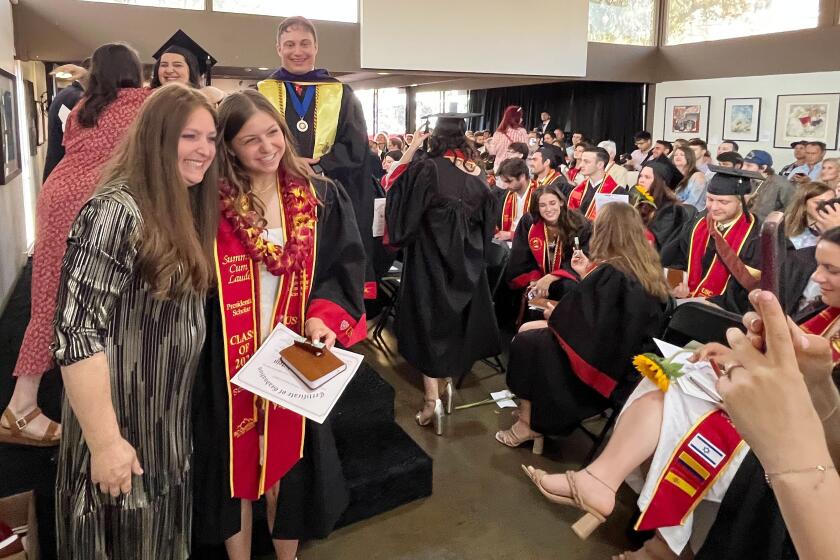Teachers Would Gain in Plan to End Loophole
Math, science and special-education teachers in poor areas may soon reap a windfall.
More than $250 million in government subsidy payments to lenders would be redirected to pay off college loans for qualified teachers under legislation recently passed by both houses of Congress. President Bush is expected to sign the bill.
The measure, called the Taxpayer-Teacher Protection Act of 2004, would temporarily close a loophole in federal law that caused the government to pay some loan companies 9.5% interest on student loans, regardless of market interest rates.
Lawmakers tried to end the practice in 1993, but lenders found a way to keep the subsidies coming under a grandfather clause intended to ease the transition period for the lenders. The loophole is costing taxpayers more than $1 billion a year, according to the Government Accountability Office.
The legislation would stop lenders from expanding their existing stable of 9.5% loans. But critics say the bill does nothing to take back government subsidies from companies that exploited the loophole after 1993, and they add that the legislation could allow some 9.5% loans to remain on the books for decades more.
Supporters say the legislation is a stopgap measure that would be in force only until January 2006. Legislation will be introduced next year to provide a comprehensive overhaul of the loan program, said Alexa Marrero, a spokeswoman for the House Committee on Education and the Workforce.
The one-year fix, sponsored by Sen. Judd Gregg (R-N.H.) and Rep. John A. Boehner (R-Ohio), is expected to save the government more than $250 million, which would be used to expand an existing program to pay off loans for schoolteachers.
Under the current program, schoolteachers who work in a designated low-income area for five years can apply to have as much as $5,000 in Stafford college loans wiped away. Stafford loans are the most common type of student debt.
The Taxpayer-Teacher Protection Act would more than triple the amount of debt cancellation for a subset of this group -- those teaching math, science or special education in low- income areas. If the bill becomes law, those teachers would be eligible to have as much as $17,500 in student debts canceled.
The catch: Not all teachers and loans qualify for the existing debt-cancellation program, and even fewer would qualify for the new program.
For the general debt-cancellation program of as much as $5,000, the teacher would have to:
* Be a “new borrower” as of Oct. 1, 1998. In other words, the teacher could not have had an outstanding Stafford loan balance before then.
* Have taught for five straight years in a qualifying low-income school. The names of qualifying schools are posted on the Department of Education’s website at www.ed.gov. Search for “Stafford Loan Teacher Cancellation.”
* Teach at least one of the five qualifying years after the 1997-98 academic year.
* Have secured the loan in question before the end of the fifth year of qualified teaching.
* Not be in default on student loan payments.
There would be two additional restrictions on those applying for the $17,500 in debt cancellation.
For this higher amount, the applicant would have to teach math, science or special education and be “highly qualified” as defined in the Elementary and Secondary Education Act of 1965, according to the legislation.
The definition of “highly qualified” can change from state to state, congressional staffer Marrero said. But all states now must have minimum standards based on educational background or proficiency testing to employ new teachers. Existing teachers will neither be fired nor denied access to the debt-cancellation programs if they don’t fit the “highly qualified” definition, however.
Teachers would apply for the debt-cancellation program through their existing lenders, according to the Department of Education. The lender would provide an application, which the teacher would fill out and have certified by the chief administrative officer of his or her school.
The lender would notify the teacher within 135 days of receiving the application about whether the debt cancellation was approved and, as appropriate, about repayment terms for any remaining balance.
Teachers also could apply for loan forbearance -- a payment hiatus -- of as many as 60 days while the lender reviewed the debt-cancellation application.
Kathy M. Kristof, author of “Investing 101” and “Taming the Tuition Tiger,” welcomes your comments and suggestions but regrets that she cannot respond individually to letters or phone calls. Write to Personal Finance, Business Section, Los Angeles Times, 202 W. 1st St., Los Angeles, CA 90012, or e-mail kathy.kristof @latimes.com. For past columns, visit latimes.com/kristof.
More to Read
Start your day right
Sign up for Essential California for news, features and recommendations from the L.A. Times and beyond in your inbox six days a week.
You may occasionally receive promotional content from the Los Angeles Times.






